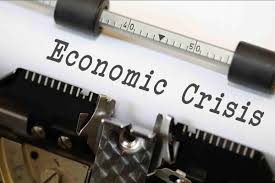U.S. Economic Crisis

Source: Thebluediamondgallery.com
An image of the words economic crisis.
April 10, 2020
Throughout 2019, the U.S. economy was booming. Then in 2020, it came crashing to a halt. A pandemic, a kind not seen since the Spanish Flu of 1919 hit the world and the United States took measures to protect its citizens. Those measures forced the United States to close its borders and for the economy to completely shut down. According to CNBC, “The global economy is heading for its worst year since the financial crisis.” The financial crisis CNBC referred to occurred in 2007-2008, and at the time economists considered it to be the most serious financial crisis since the great depression.
This crisis is far worse because for the first time in the history of the United States the government was forced to actually close the borders, stop trade, and close businesses all in the name of public safety. The government also had to approve over $2 trillion in aid to businesses to prevent the complete collapse of the economy. It is clear that this amount won’t be enough to protect all small businesses that have been forced to close and cannot pay employees. The aid package provided to businesses was designed to allow businesses to keep employees on the payroll even though they would not be working. Another aid package is already being discussed to help small businesses keep employees paid and prevent businesses from having to permanently close.
As the pandemic continues to rapture the United States, a great debate is on the horizon. The medical professionals say the economy must remain closed and people must stay indoors. The key phrase that has become common terminology these days is “social distancing.” However, economists for the United States say if the economy is closed for too long businesses will have to permanently close and the economy won’t recover.
Some business professionals ask why the economy has been shut down for this pandemic? The flu, car accidents, smoking, and even previous pandemics such as SARS had more yearly deaths than COVID-19. They feel the cure for the COVID-19 pandemic cannot be worse than the disease. Also, they feel the economy needs to be running again to save it before total collapse. The big difference with this pandemic is that even though it spreads quickly, unlike SARS and EBOLA most individuals recover from COVID-19.
Fortunately, some businesses have grown exponentially during this virus. Online shopping like Amazon has boomed to the point that products are out of stock and orders are delayed weeks, not just days. Grocery stores and wholesale stores like Costco have seen spikes in business. These companies are hiring, but they don’t equal the losses from all the other businesses that have had to close.
Socially, people are staying home, so industries like restaurants, movie theaters, airlines, hotels, and other forms of entertainment and hospitality have taken large financial blows. Parents have become teachers, guidance counselors, and entertainment directors for their children. The question then truly becomes, once this pandemic is on the decline will there be an economy to reopen? Also, what will the long term effects be from the government printing and pumping over $2 trillion dollars back into the economy.
Sydney Rofe states, “This is a scary time. Everyday the news discusses more people dying and businesses that are suffering. I see a lot of local businesses closed down, so I hope the stay at home orders end soon, so these businesses can open back up.”

